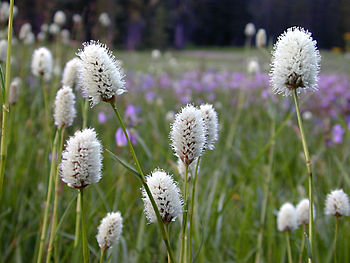- Polygonum bistortoides
-
Polygonum bistortoides Scientific classification Kingdom: Plantae (unranked): Angiosperms (unranked): Eudicots (unranked): Core eudicots Order: Caryophyllales Family: Polygonaceae Genus: Polygonum Species: P. bistortoides Binomial name Polygonum bistortoides
(Pursh) SmallPolygonum bistortoides (American bistort, western bistort, smokeweed or mountain meadow knotweed), syn. Bistorta bistortoides, is a perennial herb in the genus Polygonum.
It is distributed throughout the Mountain West in North America from Alaska and British Columbia south into California and east into the Rocky Mountains. The plant grows from montane foothills to above the timberline, although plants growing above 7,500 feet are smaller and seldom reach more than 12 inches in height. Plants in other areas may reach over half a meter-1.5 feet tall. The leaves are leathery and up to 40 centimeters long, and are mostly basal on the stem. The dense cylindrical to oblong inflorescence is packed with small white to pinkish flowers, each a few millimeters wide and with protruding stamens.
American bistort was an important food plant used by American Indians living in the Mountain West, and the roots are edible either raw or fire-roasted with a flavor resembling chestnuts. The seeds can be dried and ground into flour and used to make bread. They were also roasted and eaten as a cracked grain.
References
- Tilford, G. L. Edible and Medicinal Plants of the West ISBN 0-87842-359-1
External links
- Jepson Manual Treatment - Polygonum bistortoides
- USDA Plants Profile
- Polygonum bistortoides - Photo gallery
- Edibility: Identification and edible parts of American Bistort

This Polygonaceae article is a stub. You can help Wikipedia by expanding it.


